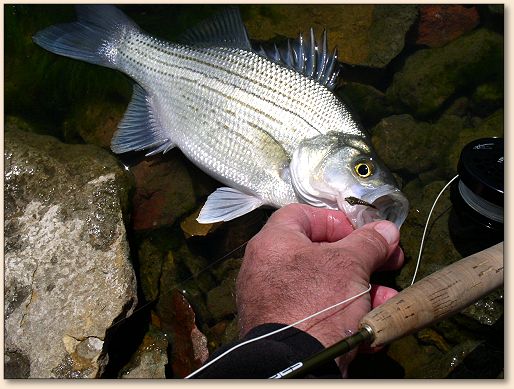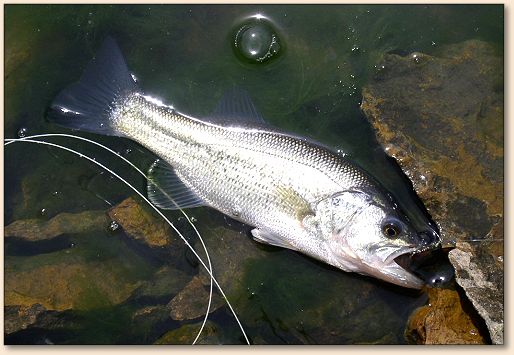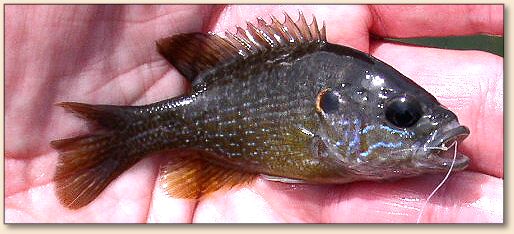|
Last Friday I ran into Larry, a Lawrence fly fisher who I
hadn't seen for a number of months. Larry knows how I like
panfishing, and while we visited he mentioned that he and
his good fishing buddy, Mike, once caught some nice bluegill
at a big federal reservoir south of Lawrence. The 'gills were
so big, Larry said, that he and Mike quit fishing for largemouth
bass just to catch the 'gills.
Larry had my undivided attention. See, I went to high
school with Larry's buddy, Mike, and I've sorta halfway
kept up with him the times I've run into him, enough to
know that Mike is 100% gung-ho bass fisher. So if those
'gills they got into were so big that Mike quit bassing,
then those had to be some serious bluegills.
After the conclusion of this conversation with Larry, I
fueled up and drove down to the lake he mentioned and camped
there overnight at a Kansas State Park. A very nice park,
as they all are. Even at midnight, though, the wind was
blowing like a hurricane. I couldn't find a weather report
on my truck radio, so all I could do was go to sleep and hope
that the next day would have better conditions.
Forget it. Saturday morning, I no sooner left the campground
and reached the water than the wind resumed full force. And
of course, Murphy's Law made it blow from a direction that
made fishing Larry's spot impossible without a long, upwind
paddle from the canoe put-in spot. (Strictly as a boat control
issue I prefer paddling into the wind and waves as opposed to
having them hit me from the side, or from astern. So it was
actually the return trip that I was more worried about, given
the cold water temperature in case of capsize accident.)
So I fished from the bank. On my first cast, I threw Old
Reliable (a #10 flashback Hare's Ear Nymph) to the upwind
side of a large, submerged tree trunk. I noticed that upwind
of this trunk and drifting on the surface was a large dead bird.
As the nymph came in, the wind bellied my line underneath the
bird and Old Reliable snagged the bird's "anchor line." What
apparently happened was this bird got tangled in a fisherman's
snagged line and unable to free itself had died of starvation.
Probably this was a cormorant that encountered some fishing
line while diving deep to catch minnows.
After this nymph loss, I had only five #10 HENs left to my name.
Bummed out and wind-buffeted, I decided to leave.
The old-time country band that I play in had a gig in Kansas
City, KS at 8PM, so it looked like the best I could do this
morning was get myself on the highway and work my way slowly
toward Kansas City, on the way scouting some new fishing spots.
Scouting is an activity I really enjoy.
My first stop was Carbondale City Lake, a lake I'd seen only
once before, and whose surface was getting blown to a froth
by the high northeast wind. As I pulled into the boat access
lot, two fishermen in a bass boat were taking out. Both men
had that thousand-yard stare. I didn't have to ask what kind
of rotten luck they'd had, but I did anyway.
"Nothing. Not one fish. This wind..." one of them sighed,
"it's been blowing like this for two months; I don't know
if it's ever going to quit."
"Tell me about it," I commiserated, "You think it's bad in
a powerboat, you ought to try fishing from a canoe in this
stuff."
After these powerboat fishermen left, I had the public parking
lot to myself and decided to take a lunch break before moving
on. Once din-din was over I almost got behind the wheel and
left, but I'd been looking at a small area of calm water at
the west end of the lake dam, between the dam and the boat ramp.
Well, why not? I'm here.
I rigged up my rod, tippy-toed down to the water's edge and
gave my nymph the old heave-ho. First cast, nothing. Looking
to my right, I spied the tip of a tree branch poking out of
the water. This branch tip is only 20 feet away from where
the two bass boaters had just gunned their craft onto its
trailer in a commotion of noise and vibration. But the
branch tip constituted the only natural cover in view, so
I decided to give it the cowboy try out of general principal.
Old Reliable came down five feet left of the branch tip and
I gave him a 5-count before commencing the retrieve. Slowly
and absent-mindedly stripping him toward me using 4-inch pulls,
I was rudely jolted to battle stations by a crunching strike
the likes of which I've seldom experienced. It was one of
those hits where your left thumb and index finger instinctively
squeeze down on the escaping line to keep it from being "stolen."
Where the "thief" fish actually hooks itself? This is what
happened.
The fish took, I took back, the fish took and I took back, and
soon I saw a silvery flash appear underwater. Then I saw rows
of black marking running down that silvery side, and now I
remember the display sign posted near the boat ramp, where it
says Carbondale City Lake has a population of wipers. ("Wipers"
for those who've never heard the term, are a hybrid freshwater
fish. Genetically half white bass, half striped bass.)
Wipers are an open water fish. I've visited before with
guys who've been lucky enough to get into a school of wipers
where all the fish are 6 to 8-lbs? They said that with a
wiper that size, on its first run - no matter what tackle
you're using - all you can do is hang on and pray that your
drag is set properly because there's no turning the fish.
That was almost the case with this fish...IF it was a wiper.
I was finally able to land it and luckily I'd brought my
camera. I took a photo of it, and readers can examine the
photo and if anybody knows for sure, I'd appreciate a
confirmation.

If this is a wiper, it's the first one I've ever caught.
The fish was around 14 inches long. The photo is deceiving
as to the fish's size; I deliberately held its head closer
to the camera lens, so you're seeing the fish at a front
quartering angle. (I did this to show off Old Reliable and
give him due credit for enabling the catch.) I unhooked
the fish and released it back to the lake. Zoom, it was
gone.
Well, now! This quick success threw ice water on my plan
to stay on the road today scouting lakes. The only scouting
I would be doing now was seeing whether more of these
black-striped rockets were prowling the face of the dam
waylaying aquatic nymphs of the type Old Reliable imitates.
The hard northeast wind was quartering across this east/west
dam, creating in the dam's lee a narrow band of still water
that I could investigate using roll casts. But to make those
casts as easy as possible I needed to walk way down to the far
east end of the dam and then fish my way back west, thus putting
the quartering wind more at my back so I could keep Old Reliable
out in front of me as I crept along.
I worked the calm east corner of the dam first, worked it for
about 10 minutes without success. Carefully sneaking westward
40 yards across loose rocks on the dam face, I threw Old Reliable
out again. Because the slope of the dam looked more pronounced
here the water looked deeper, so I gave the nymph a 30-second
countdown then began a super slow-motion retrieve.
Beats me if aquatic nymphs in lakes reside at great depths, and
I don't know exactly how far an un-weighted #10 nymph is capable
of sinking in 30 seconds time. It'd be a ways down, you'd think.
However far, Old Reliable was running deep and moving slow, and
he got ambushed about halfway back to the dam. The evil-doer
was a largemouth bass of about a pound, and for his trouble he
got photographed, unhooked and released.

Continuing down the otherwise featureless face of the dam,
I reached a place where a Wildlife & Parks floating fish
feeder had got blown from its anchor and come to grief on
the rocks. A sad sight, but this wrecked structure sticking
out into the lake did create a modest bit of cover that would
not have been present otherwise. I rolled a cast 20 feet
beyond the fish feeder, angling my throw at a 45-degree
angle. I gave Old Reliable a 15-second countdown this time,
not merely for variety's sake but also to work a different
depth zone.
Somebody down there liked the looks of a nymph and grabbed
it hard. This was a much more powerful fish than the wiper
(or white bass) I'd caught back at the dam's west end.
Still, for a few seconds things went well and I was full
of hope: the fish, under maximum pressure, came my way
grudgingly and then paused some 15 feet away, swimming
back and forth directly in front of me, staying deep.
Then apparently it connected the strange prickly
sensation in its jaw to the possibility that danger was
close by. The fish wheeled about, tached its engine to
catapult launch RPM, punched up the afterburner and...
was...gone.
In a flash of time the coils of stripped line at my feet
got yanked through the guides, my reel handle blurred 20
or 30 revolutions and then this mystery fish, now some
distance away, came off. I never saw it, but if I'd
walked around to the other side of the lake I might
have found it flopping in the grass after it ran up
onto dry land.
This mid-depth take and the fish's escape velocity
suggested that it was a wiper. If so, then I have
to say that "wiper" is an appropriate name for this
fish; a person who fishes for them should keep a
fresh roll of toilet paper handy because you'll
need something to wipe with if you ever connect
with a big one.
A hundred feet or so beyond the grounded fish feeder,
Old Reliable fooled another largemouth bass, a bigger
one that I would have photographed had it not
self-released just as I was reaching down to thumb its jaw.
And then a few minutes later Old Reliable absorbed a
thunderclap hit from one of the true terrors of Kansas
freshwater. There's fish that eat bugs, then there's
fish that angrily gobble down any bug they can fit their
mouth around. The fish I caught next could be called the
freshwater version of an ocean jewfish. Large head and
huge mouth in relation to its body length. A heavy hitter,
bigtime. I was lucky enough to land this one, and grateful
to the recent Bulletin Board advice about de-barbing my
hooks to enable safe releases.
Here in all his glory, I give you "The Creature from
Carbondale City Lake."

I'm just thankful this brute green sunfish wasn't bigger,
else he'd have torn off my left thumb. And yes, the nymph
I caught him on can't be seen but it's there inside his
mouth and it's a #10 flashback Hare's Ear nymph.
One thing I learned from this "scouting stop" is that
deep-nymphing the rocky face of a lake dam is definitely
a profitable enterprise for a fly fisher. I'll definitely
be doing it again as there are times when various fish
species congregate along the face of rocky dams for
feeding and spawning. Aquatic nymphs doubtless enjoy
the protection afforded by all the rocks. So by using
a slow-sinking nymph like an un-weighted #10 HEN, it's
possible to employ various countdown intervals and thereby
explore multiple depth zones until you locate the fish.
And another thing I learned: In lakes where wipers are
abundant, or even a possibility, it pays to be mentally
prepared for one of their lightning bolt strikes. ~ Joe
About Joe:
 From Douglas County, Kansas, Joe is a former municipal and
federal police officer. In addition to fishing, he hunts
upland birds and waterfowl, and for the last 15 years
has pursued the sport of solo canoeing. On the nearby
Kansas River he has now logged nearly 5,000 river miles
while doing some 400 wilderness style canoe camping
trips. A musician/singer/songwriter as well, Joe's
'day job' is with the U.S. General Services Adminstration.
From Douglas County, Kansas, Joe is a former municipal and
federal police officer. In addition to fishing, he hunts
upland birds and waterfowl, and for the last 15 years
has pursued the sport of solo canoeing. On the nearby
Kansas River he has now logged nearly 5,000 river miles
while doing some 400 wilderness style canoe camping
trips. A musician/singer/songwriter as well, Joe's
'day job' is with the U.S. General Services Adminstration.
Joe at one time was a freelance photojournalist who wrote the
Sunday Outdoors column for his city newspaper. Outdoor
sports, writing and music have never earned him any money,
but remain priceless activities essential to surviving the
'day job.'
|




 From Douglas County, Kansas, Joe is a former municipal and
federal police officer. In addition to fishing, he hunts
upland birds and waterfowl, and for the last 15 years
has pursued the sport of solo canoeing. On the nearby
Kansas River he has now logged nearly 5,000 river miles
while doing some 400 wilderness style canoe camping
trips. A musician/singer/songwriter as well, Joe's
'day job' is with the U.S. General Services Adminstration.
From Douglas County, Kansas, Joe is a former municipal and
federal police officer. In addition to fishing, he hunts
upland birds and waterfowl, and for the last 15 years
has pursued the sport of solo canoeing. On the nearby
Kansas River he has now logged nearly 5,000 river miles
while doing some 400 wilderness style canoe camping
trips. A musician/singer/songwriter as well, Joe's
'day job' is with the U.S. General Services Adminstration.